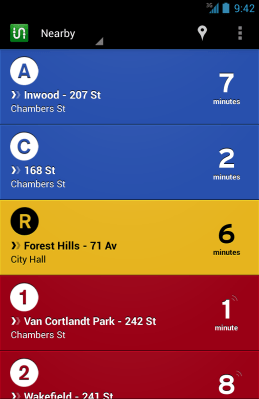Montreal-based startup The Transit App is expanding its mobile domain after a strong showing at the Founder Fuel demo day earlier this month. The app offers real-time transit directions, notifications and route planning, and on Android brings most of the features from its iOS counterpart to devices running Google’s mobile OS, with full feature parity planned to arrive in earnest.
The Transit App offers a great experience for regular commuters looking to check schedules and stops for their regular and nearby bus and subway stops in major cities around the world that support open-data initiatives. Transit App founder Sam Vermette explained in an interview that more and more companies are realizing the benefits of making that data public, since it means outside sources can help them develop insight on what needs changing with their own transit systems. Mexico City and Paris have recently opened up their data, which enabled Transit App to add them to their database.
“We’ve been working on it for the past two months, and we’re really excited to see how it’s received,” Vermette said. “The fact that Android already has Google Maps pre-installed on the phone is definitely going to give us a good idea of what it’s like to compete on a platform that already has a great poly-transit solution.”
[gallery columns="5" ids="853426,853427,853430,853431,853432"]
That’s important as Vermette is anticipating that Apple will introduce transit directions to its own mapping app after acquiring HopStop last month. iOS and its lack of native transit directions in the Apple Maps app have helped propel The Transit App to some impressive early milestones, but it’s one thing to capitalize on a huge gap in a native platform offering and another to compete with a built-in, widely respected transit direction service.
Vermette believes that what his company offers is something that’s different enough from Google Maps to attract an audience of dedicated commuters, however. Transit App is designed from the ground up for people who use public transit daily, and surfaces immediately useful information right when you launch the app. That’s very different from how transit works in Google Maps, for instance, which mostly is about route planning, or with Google Now, which surfaces nearby stops but not necessarily the ones commuters are looking to use.
The Transit App is free to use on Android and supports a wide range of devices, which Vermette says is one of the advantages of expanding to Android, as the user base of Android devices covers a wide range of demographics vs. iOS. At launch, the Android version lacks real-time tracking of buses and trains, but that and other features from iOS will be coming soon, as Vermette said getting the app up and gathering feedback was top priority for his startup’s small team.
